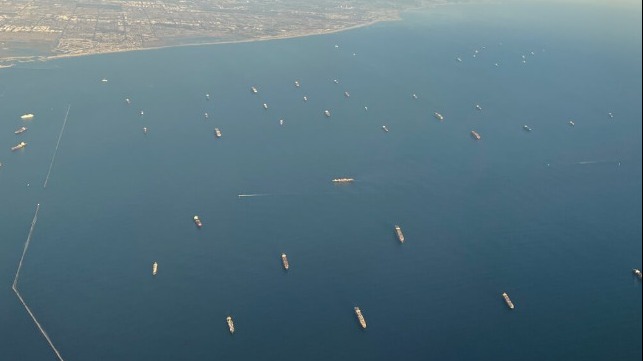California Takes Action to Relieve Record-Setting Port Congestion

With the onslaught of vessels continuing to arrive off Southern California’s ports and no signs of congestion easing both state and federal leaders are looking at all actions that can be taken to improve the flow of goods along the supply chain. California Governor Gavin Newsom signed an executive order marshaling the state’s resources. Reports indicate that the Biden Administration is looking at even more drastic measures to decrease the backlog.
The Southern California port complex set five new records yesterday alone, with the Marine Exchange of Southern California reporting that they expected the record levels to rise and then remain steady. In the October 20 update, they reported that 25 vessels of all types were scheduled to arrive in the next three days. This comes in addition to a record 161 vessels in port with a record 106 either at anchor or holding out at sea because the anchorages are full. The other records included 50 vessels in holding areas, including 39 containerships, and a total of 103 container ships either at berth or waiting offshore.
The Washington Post and CNN are both reporting that the Biden Administration has considered activating the National Guard in its efforts to reduce the backlog. The UK considered a similar step recently when it was also faced with a shortage of truck drivers to distribute gasoline. During yesterday’s daily press briefing at the White House, CNN asked if the U.S. Navy might also be deployed, to which the response was that the Biden Administration was not removing any option from consideration.
At the state level, California’s governor signed an executive order directing state agencies to identify additional ways to alleviate congestion at California ports. With the ports of Los Angeles and Long Beach at the epicenter of the crisis, Newsom directs state agencies to continue coordinating with the Biden Administration Supply Chain Disruptions Task Force while also ordering specific state actions. In the near term, the governor told state agencies to identify properties that could be used to increase storage capacity for containers, create additional workforce training and education programs to increase employment along the supply chain, and possibly most importantly to identify priority freight routes to provide more access at the ports for trucks.
California’s Department of Finance was also directed to work with state agencies to develop longer-term solutions for consideration in the state’s next budget to support port operations. The governor said this could include port and transportation infrastructure improvements, electrification of the goods movement system from port to delivery, and workforce development movement.
“California’s ports are critical to our local, state, and national economies and the state is taking action to support goods movement in the face of global disruptions,” said Governor Newsom. “My administration will continue to work with federal, state, labor, and industry partners on innovative solutions to tackle immediate challenges while also bringing our distribution processes into the 21st century.”

that matters most
Get the latest maritime news delivered to your inbox daily.
Newsom’s executive order builds on earlier efforts this year by the Governor’s Office of Business and Economic Development (GO-Biz) to ease supply chain issues by engaging the diverse network of stakeholders along the supply chain to discuss key challenges and identify short-term and long-term solutions.
All of this comes as residents are complaining about the truck traffic and pollution increasing around the California ports. Residents’ complaints were highlighted when a tractor-trailer dumped an improperly secured container on a Los Angeles side street, crushing a parked car.
